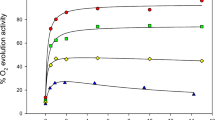Abstract
The present study demonstrates that the mitochondrial respiratory chain includes not three but four energy coupling sites, the fourth site being localized at the NADPH→NAD+ step.
-
1.
The NADPH→NAD+-directed transhydrogenase reaction in sonicated beef heart submitochondrial particles energizes the particle membrane as judged by two membrane potential probes, i.e. uptake of a penetrating anion, phenyldicarbaundecaborane (PCB−), and enhancement of anilinonaphthalene sulfonate (ANS−) fluorescence.
-
2.
The reverse reaction (NADH→NADP+) is accompanied by the oppositely directed anion movement, i.e. PCB− efflux.
-
3.
Being insensitive to rotenone, antimycin, cyanide, and oligomycin, both the influx and efflux of PCB− coupled with transhydrogenase reaction can be prevented or reversed by uncouplers.
-
4.
Equalization of concentrations of the transhydrogenase substrates and products also prevents (or reverses) the PCB− influx coupled with oxidation of NADPH by NAD+, as well as the PCB− efflux coupled with reduction of NADP+ by NADH.
-
5.
The transhydrogenase-linked PCB− uptake depends linearly on the energy yield of the oxidation reaction calculated according to formula
$$\Delta G = RTln\frac{{[NADPH] x [NAD^ + ]}}{{[NADP^ + ] x [NADH]^ \cdot }}$$No threshold value of Δ was found. Measurable PCB− transport was still observed at Δ≤0.5 kcal/mole NADPH oxidized.
-
6.
Partial uncoupling of transhydrogenase reaction and PCB− transport, induced by low concentrations ofp-trifluoromethoxycarbonylcyanide phenylhydrazone (FCCP), dinitrophenol, or by removing coupling factor F1, results in the decrease of the slope of the straight line showing the PCB− uptake as a function of Δ. Oligomycin improves the coupling in F1-deprived particles, the slope being increased. Rutamycin, dicyclohexylcarbodiimide (DCCD) and reconstitution of particles with F1, also increase the coupling.
-
7.
In phosphorylating particles oxidizing succinate by O2, both the energy-dependent NADH→NADP+ hydrogen transfer and PCB− influx possess equal sensitivity to FCCP, which is lower than the sensitivity of oxidative phosphorylation. Similarly, the decrease in the succinate oxidation rate induced by malonate arrests first phosphorylation and then under higher malonate concentration, PCB− influx. The rate of NADPH→NAD+ transhydrogenase reaction was found to be lower than the threshold value of rate of succinate oxidation, still coupled with phosphorylation. Respectively, the values of PCB− uptake under transhydrogenase reaction are lower than those inherent in phosphorylating oxidation of succinate.
The conclusion is made that the NADPH→NAD+-directed transhydrogenase reaction generates the membrane potential of the same polarity as respiration and ATP hydrolysis but of a lower magnitude (“plus” inside particles; the forward hydrogen transfer). The NADH→NADP+-directed transhydrogenase reaction forms the membrane potential of the opposite polarity (“minus” inside particles; the reverse hydrogen transfer). Under conditions used, the transhydrogenase-produced membrane potential proves to be too low to support ATP synthesis (and, most probably, the synthesis of any other high-energy compound) maintaining, nevertheless, some electrophoretic ion fluxes.
A conclusion is made that transhydrogenase forms a membrane potential with no high-energy intermediates involved.
Similar content being viewed by others
Abbreviations
- PCB− :
-
phenyl dicarbaundecaborane
- ANS− :
-
anilinonaphthalene-sulphonate
- FCCP:
-
p-trifluoromethoxycarbonylcyanide phenylhydrazone
- DCCD:
-
dicyclohexylcarbodiimide
- SMP:
-
submitochondrial particles
References
S. P. Colowick, N. O. Kaplan, E. F. Neufeld and M. M. Ciotti,J. Biol. Chem.,195 (1952) 95.
N. O. Kaplan, S. P. Colowick and E. F. Neufeld,J. Biol. Chem.,205 (1953) 1.
L. Danielson and L. Ernster,Biochem. Biophys. Res. Commun.,10, (1963) 91.
L. Danielson and L. Ernster,Biochem. Z.,338 (1963) 188.
C.-P. Lee and L. Ernster,Biochim. Biophys. Acta,81, (1964), 187.
P. Mitchell,Chemiosmotic Coupling in Oxidative and Photosynthetic Phosphorylation, Glynn Research, Bodmin, 1966.
C.-P. Lee and L. Ernster,Biochim. Biophys. Acta Library 7 (1966) 218.
E. A. Liberman and L. M. Tsofina,Biofizika USSR,14 (1969) 1017.
L. L. Grinius, A. A. Jasaitis, Yu. P. Kadziauskas, E. A. Liberman, V. P. Skulachev, V. P. Topali, L. M. Tsofina and M. A. Vladimirova,Biochim. Biophys. Acta,216 (1970) 1.
P. I. Isaev, E. A. Liberman, V. D. Samuilov, V. P. Skulachev and L. M. Tsofina,Biochim. Biophys. Acta,216 (1970) 22.
E. A. Liberman and V. P. Skulachev,Biochim. Biophys. Acta,216 (1970) 30.
V. P. Skulachev,FEBS Letters,11 (1970) 301.
V. P. Skulachev,Current Topics in Bioenergetics,4 (1971) 127.
L. L. Grinius and V. P. Skulachev,Biokhimiya USSR,36 (1971) 430.
M. Hansen and A. L. Smith,Biochim. Biophys. Acta,81 (1964) 214.
F. L. Crane, J. L. Glenn and D. E. Green,Biochim. Biophys. Acta,22 (1956) 475.
A. Tzagoloff, D. H. McLennan and K. H. Byington,Biochemistry,7 (1968) 1956.
E. A. Liberman and V. P. Topali,Biofizika USSR,14 (1969) 452.
A. A. Jasaitis, V. V. Kuliene and V. P. Skulachev,Biochim. Biophys. Acta,234 (1971) 177.
V. P. Skulachev,Energy Accumulation in the Cell, Nauka Press, Moscow, 1969 pp. 251–257.
P. Mitchell and J. Moyle,Nature,208 (1965) 1205.
J. Rydstrom, A. T. DaCruz and L. Ernster,European J. Biochem.,17 (1970) 56.
P. Mitchell and J. Moyle,European J. Biochem.,7 (1969) 471.
J. B. Jackson and A. R. Crofts,FEBS Letters,4 (1969) 185.
A. Azzi and M. Santato,Federation Proc.,29 (1970) 733.
P. Hinkle and P. Mitchell,J. Bioenergetics,1 (1970) 45.
V. P. Skulachev,J. Bioenergetics,3 (1972).
L. Ernster and C.-P. Lee,Ann. Rev. Biochem.,33 (1964) 729.
S. Massari and G. F. Azzone,Europ. J. Biochem.,12 (1970) 310.
Author information
Authors and Affiliations
Rights and permissions
About this article
Cite this article
Dontsov, A.E., Grinius, L.L., Jasaitis, A.A. et al. A study on the mechanism of energy coupling in the redox chain. J Bioenerg Biomembr 3, 277–303 (1972). https://doi.org/10.1007/BF01515975
Received:
Issue Date:
DOI: https://doi.org/10.1007/BF01515975




